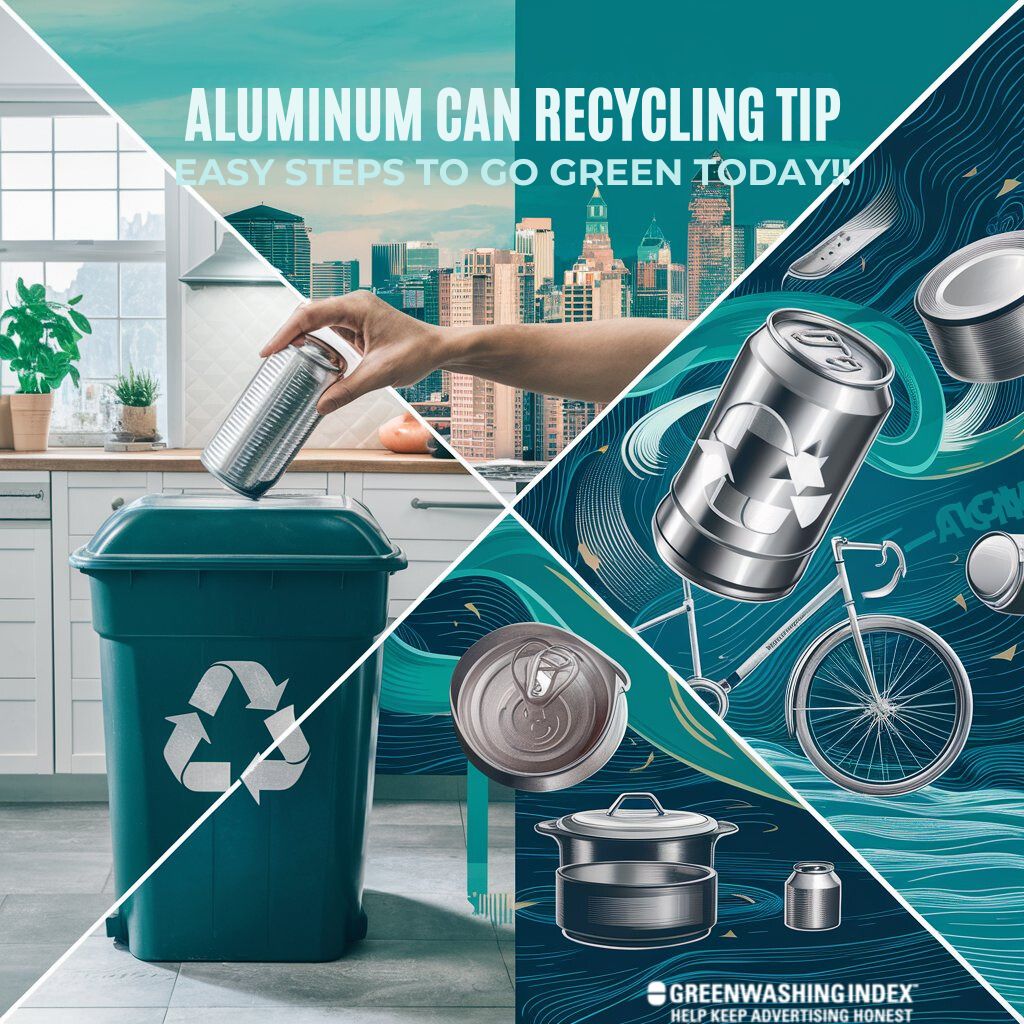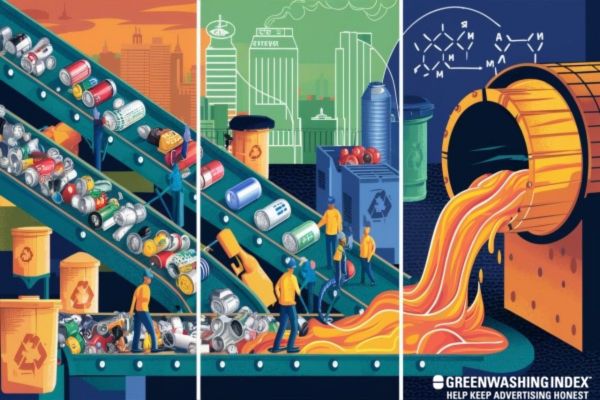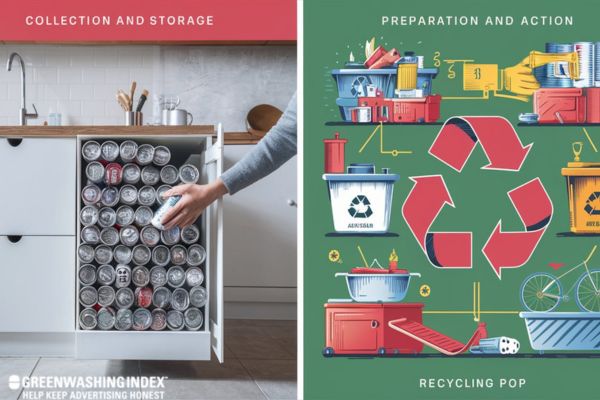

Let’s talk about aluminum can recycling and how we can make a positive impact with just a few simple actions. By setting up designated bins, rinsing our cans before tossing them, and participating in local recycling programs, we can greatly reduce waste and contribute to a sustainable future.
But did you know there are even more ways to optimize our recycling efforts and make sure we’re doing it right? Stick around as we explore these practical tips and uncover some surprising facts about aluminum can recycling.
When we recycle aluminum cans, we save a lot of energy and reduce pollution, which benefits our environment. It also helps our economy by conserving resources and saving money, with over $800 million saved each year in the US alone. Additionally, recycling aluminum supports a circular economy, ensuring materials are reused efficiently.
Recycling aluminum cans not only conserves energy but also greatly reduces air pollution and saves valuable resources. When we recycle aluminum, we save up to 95% of the energy needed to produce new aluminum from raw materials. This energy saving is important because producing aluminum from bauxite ore is highly energy-intensive.
Additionally, recycling aluminum cans cuts down air pollution by up to 95%, making our air cleaner and healthier to breathe. By recycling, we also help conserve valuable natural resources. Here are some key benefits:
Not only does recycling aluminum cans help the environment, but it also offers significant economic benefits and resource conservation advantages. When we recycle aluminum, we save a lot of money and resources. For instance, the United States saves over $800 million each year by recycling all aluminum cans.
This is because producing new aluminum from recycled cans requires much less energy and raw materials compared to making it from scratch. By recycling aluminum, we also conserve natural resources. Mining for new aluminum ore can be damaging to the environment and uses a ton of energy. In contrast, recycling aluminum saves 95% of the energy that would be used to produce new aluminum.
This means that:
In addition to these benefits, recycling aluminum cans supports the economy by creating jobs in the recycling industry. It’s a win-win situation that helps us protect the planet and boost the economy at the same time.
Aluminum recycling plays a crucial role in the circular economy by keeping valuable materials in use and reducing the need for new resources. When we recycle aluminum cans, we contribute to a system where materials are reused and repurposed, minimizing waste and the impact on our planet. This continuous loop of recycling helps us conserve natural resources and reduces the energy required to produce new aluminum.
By recycling, we’re saving up to 95% of the energy needed to create new aluminum from raw materials. This significant energy savings means we can power essential devices and reduce our reliance on fossil fuels, which in turn, lowers greenhouse gas emissions. In fact, recycling just one aluminum can save enough energy to power a 100-watt bulb for four hours or run a TV for three hours.
Additionally, recycling aluminum cans dramatically cuts down air pollution by 95%. This is because producing new aluminum from raw materials involves extensive mining and refining processes, which are highly polluting. By keeping aluminum in the recycling loop, we not only save energy and resources but also create a cleaner, healthier environment for everyone.
Let’s look at how aluminum cans go from our recycling bins back to store shelves. First, the cans are collected and sorted to make sure only aluminum is processed. Then they’re melted down and purified before being transformed into new aluminum products, ready for reuse.

Effective aluminum can recycling starts with the diligent collection and proper sorting of used cans. First, we need to gather aluminum cans from our homes, schools, and workplaces. It’s easy to set up a designated recycling bin in convenient locations to make this step as smooth as possible.
Once we’ve collected a substantial amount, it’s time to sort them correctly. Sorting is essential because it guarantees that only aluminum cans enter the recycling stream. Mixing in other materials can cause contamination and complicate the recycling process. We should remove any non-aluminum items, such as plastic caps or food remnants. Rinsing out the cans to eliminate any leftover liquids or food particles is also a good practice.
Once we’ve sorted the cans, the next step involves melting them down to remove impurities and prepare the aluminum for reuse. First, the aluminum cans are shredded into small pieces to increase the surface area. This makes the melting process faster and more efficient.
The shredded aluminum is then placed in a large furnace and heated to around 1220 degrees Fahrenheit, which is the melting point of aluminum. During this stage, any remaining impurities, such as paint or plastic liners, are burned off or separated. To make certain the aluminum is as pure as possible, we add chemicals called fluxes that bind to impurities and help remove them from the molten metal.
This purification process is crucial because it ensures that the recycled aluminum is of high quality and ready for the next phase of recycling. Once the aluminum is completely melted and purified, it’s poured into molds to form large blocks called ingots. These ingots are then cooled and solidified, ready to be transformed into new aluminum products.
After the aluminum is poured into ingots and cooled, we can start transforming it into new aluminum products. First, the ingots are sent to a rolling mill where they’re flattened into thin sheets. These sheets are rolled multiple times until they reach the desired thickness. The aluminum sheets are then cut into different shapes depending on what product we want to make.
Next, the cut pieces are formed into cans, foil, or other items. This shaping process involves pressing or stamping the aluminum to achieve the right form. For example, making new cans requires specialized machines that mold the aluminum into cylindrical shapes and attach tops and bottoms.
After shaping, the new aluminum products undergo a quality check to make certain they meet industry standards. Any defective items are recycled again, minimizing waste. Finally, the products are packaged and shipped to stores, ready for consumers to use.
Recycling aluminum not only saves energy—up to 95% compared to making new aluminum from raw materials—but also reduces air pollution by the same percentage. By following these steps, we help conserve resources and protect the environment, making aluminum recycling an important part of our green efforts.
Let’s look at some key statistics to understand the impact of aluminum can recycling. In the U.S., about 50% of aluminum cans get recycled, while globally, the rate is even higher at 76%. Recycling aluminum saves 95% of the energy required to produce new aluminum, which also translates into significant reductions in air pollution and economic savings.
In the U.S., aluminum can recycling rates hover around 50%, while globally, the efficiency rate impressively hits 76%. These numbers show us how important and effective aluminum recycling can be. When we recycle aluminum cans, we’re not only reducing waste but also conserving valuable resources. This is essential for maintaining a sustainable environment.
Let’s look at some interesting statistics to understand the situation better:
| Category | Statistic |
|---|---|
| U.S. Aluminum Can Recycling | Around 50% |
| Global Recycling Efficiency | 76% |
| Recycled Content in U.S. Cans | Over 50% |
| U.S. Container & Packaging | 34.9% (2018 data) |
Recycling rates in the U.S. might seem lower compared to the global average, but there’s still a significant impact. Over half of the aluminum used in new cans comes from recycled materials. This means that every can we recycle contributes to this cycle, reducing the need for new raw materials.
Understanding these statistics helps us see the big picture. By recognizing where we stand, we can find ways to improve. If we all pitch in and recycle more, we can push these numbers higher and make a difference.
Recycling aluminum cans saves an impressive 95% of the energy required to produce new aluminum from raw materials. This means that every time we choose to recycle a can, we greatly reduce the energy needed for its production. For instance, the energy saved by recycling just one aluminum can is enough to power a 100-watt bulb for four hours or run a TV for three hours.
Moreover, recycling aluminum also leads to substantial reductions in air pollution. By recycling, we can decrease air pollution by up to 95%, making a big difference in our overall environmental impact. This is because producing aluminum from raw materials releases a lot more pollutants compared to using recycled materials.
Globally, the efficiency rate for recycling aluminum stands at 76%, showing that many countries are making good progress in this area. However, in the United States, the aluminum container and packaging recycling rate was 34.9% in 2018. While this is a positive number, there’s still room for improvement.
In addition to energy savings, our collective recycling efforts contribute to reducing harmful emissions and conserving natural resources, making our planet healthier and more sustainable for future generations.
Beyond the environmental benefits, aluminum recycling also has significant economic implications that contribute to our overall financial well-being. For instance, recycling aluminum saves a lot of money because it uses 95% less energy than making new aluminum from raw materials. This energy saving translates to over $800 million in annual savings in the U.S. alone. Imagine what we could do with that kind of money!
Additionally, aluminum cans have a high recycling rate. In 2011, the U.S. had a recycling rate of 54.2% when excluding imported cans. Even though the general estimate is around 50%, it’s still a valuable contribution to our economy. Since over 50% of the content in aluminum cans comes from recycled materials, we reduce the need for new raw materials, which helps keep costs down.
Globally, the aluminum recycling efficiency rate stands at 76%. This high rate shows how effective the recycling process is worldwide. When we recycle aluminum, we also cut down on the costs associated with air pollution and energy consumption. By doing our part in recycling, we’re not just helping the planet, we’re also making smart economic choices that benefit everyone.
Let’s talk about how we can make our aluminum can recycling efforts more effective. First, we should use proper collection and storage methods to keep our cans organized and ready for recycling. It’s also important to clean our cans before recycling them and participate in community recycling programs to maximize our impact.

Effective aluminum can recycling begins with proper collection and storage methods to guarantee the highest quality of recyclable material. Let’s go over some simple steps we can follow to make our recycling efforts more effective and efficient.
First, we need to set up a designated container for collecting aluminum cans. It’s crucial to keep this container separate from other recyclables to avoid contamination. Once we’ve our collection container ready, we should place it in a convenient location, such as the kitchen or garage, to make it easy to remember and use.
Next, we should establish a routine for regularly emptying and cleaning the collection container. This helps prevent any unwanted odors or pests. Here’s a simple checklist to guide us:
Clean cans are essential for the recycling process because they guarantee a higher quality of recyclable material and prevent contamination. When we rinse out our aluminum cans, we help make certain that the recycling process is efficient and effective.
Dirty cans can introduce food residues and other contaminants that can spoil batches of recyclable materials, making the entire process less efficient and more costly.
Here are three easy steps to make sure our cans are ready for recycling:
Participating in community recycling programs is a fantastic way to boost our collective aluminum can recycling efforts. When individuals join these programs, they make it easier for everyone to recycle more efficiently. These programs often provide resources like collection bins and scheduled pickups, making it convenient to recycle aluminum cans.
First, let’s find out if our local community has a recycling program. Many towns and cities have websites that list available services. If there’s uncertainty, individuals can call the local government office to inquire. Once individuals are aware of what’s available, they can follow the guidelines provided. This typically includes sorting aluminum cans from other recyclables and ensuring they’re clean before placing them in the correct bin.
Next, individuals can encourage their neighbors to participate. Community meetings or social media groups are great places to share information and tips about recycling. By working together, a bigger impact can be made. Additionally, some programs offer incentives like rewards or credits for recycled materials, motivating more people to join.
Yes, aluminum cans are highly recyclable. They can be melted down and reformed into new cans or other aluminum products with minimal loss of quality. This is a closed-loop system that allows for continuous reuse.
The number of cans needed to earn $100 varies depending on the current price of aluminum scrap. Generally, you’ll need several hundred cans, around 500 to 1000, to reach $100.
While recycling aluminum cans is generally beneficial, a disadvantage lies in the energy needed to transport cans to recycling facilities. The distance traveled and transportation method can impact the overall energy savings gained from recycling.
By recycling aluminum cans, we can make a significant impact on the environment. Let’s collect, sort, and rinse our cans to keep the recycling stream clean. Crushing cans saves space, and setting up recycling bins at home makes the process easier.
Participating in community programs boosts our efforts. Together, we can promote sustainability and create a greener world. So, let’s start recycling aluminum cans today and contribute to a healthier planet.
